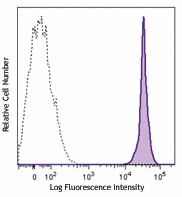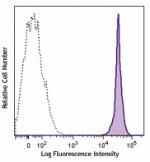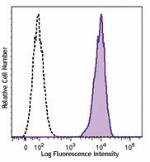- Clone
- 6C9 (See other available formats)
- Regulatory Status
- RUO
- Other Names
- LCA, T200
- Isotype
- Mouse IgG1

-

Marmoset peripheral blood lymphocytes were stained with CD45 (clone 6C9) PE (filled histogram) or mouse IgG1, κ PE isotype control (open histogram).
| Cat # | Size | Price | Quantity Check Availability | ||
|---|---|---|---|---|---|
| 250204 | 100 µg | $256.00 | |||
CD45 is a 180-240 kD single chain type I membrane glycoprotein also known as leukocyte common antigen (LCA) and T200. It is a tyrosine phosphatase expressed on the plasma membrane of all hematopoietic cells, except erythrocytes and platelets. CD45 is a signaling molecule that regulates a variety of cellular processes including cell growth, differentiation, cell cycle, and oncogenic transformation. CD45 plays a critical role in T and B cell antigen receptor-mediated activation by dephosphorylating substrates including p56Lck, p59Fyn, and other Src family kinases. CD45 non-covalently associates with lymphocyte phosphatase-associated phosphoprotein (LPAP) on T and B lymphocytes. CD45 has been reported to bind galectin-1 and to be associated with several other cell surface antigens including CD1, CD2, CD3, and CD4.
Product Details
- Verified Reactivity
- Common Marmoset
- Antibody Type
- Monoclonal
- Host Species
- Mouse
- Immunogen
- Marmoset mononuclear cells
- Formulation
- Phosphate-buffered solution, pH 7.2, containing 0.09% sodium azide.
- Preparation
- The antibody was purified by affinity chromatography and conjugated with PE under optimal conditions.
- Concentration
- 0.2 mg/ml
- Storage & Handling
- The antibody solution should be stored undiluted between 2°C and 8°C, and protected from prolonged exposure to light. Do not freeze.
- Application
-
FC - Quality tested
- Recommended Usage
-
Each lot of this antibody is quality control tested by immunofluorescent staining with flow cytometric analysis. For flow cytometric staining, the suggested use of this reagent is ≤0.125 µg per million cells in 100 µl volume. It is recommended that the reagent be titrated for optimal performance for each application.
- Excitation Laser
-
Blue Laser (488 nm)
Green Laser (532 nm)/Yellow-Green Laser (561 nm)
- Application Notes
-
Additional reported applications (for the relevant formats) include: immunohistochemical staining of frozen spleen sections1 and Western blotting1. The 6C9 antibody has been reported to not cross-react with humans, cynomolgus monkeys, or squirrel monkeys.
-
Application References
(PubMed link indicates BioLegend citation) -
- Ito R, et al. 2008. Immunol. Lett. 121:116. (IHC, WB)
- Product Citations
-
- RRID
-
AB_2562120 (BioLegend Cat. No. 250204)
Antigen Details
- Structure
- Tyrosine phosphatases, type I transmembrane protein
- Distribution
-
Hematopoietic cells, except circulating erythrocytes or platelets
- Function
- TCR and BCR mediated activation
- Ligand/Receptor
- Galectin-1, CD2, CD3, CD4
- Biology Area
- Cell Biology, Immunology, Inhibitory Molecules, Neuroscience, Neuroscience Cell Markers
- Molecular Family
- CD Molecules
- Antigen References
-
1. Thomas M. 1989. Annu. Rev. Immunol. 7:339.
2. Trowbridge I and Thomas M. 1994. Annu. Rev. Immunol. 12:85. - Gene ID
- 100385061 View all products for this Gene ID
- UniProt
- View information about CD45 on UniProt.org
Other Formats
View All CD45 Reagents Request Custom Conjugation| Description | Clone | Applications |
|---|---|---|
| Purified anti-marmoset CD45 | 6C9 | FC,IHC-F,WB |
| PE anti-marmoset CD45 | 6C9 | FC |
| Biotin anti-marmoset CD45 | 6C9 | FC |
Compare Data Across All Formats
This data display is provided for general comparisons between formats.
Your actual data may vary due to variations in samples, target cells, instruments and their settings, staining conditions, and other factors.
If you need assistance with selecting the best format contact our expert technical support team.
-
Purified anti-marmoset CD45

Marmoset peripheral blood lymphocytes were stained with puri... -
PE anti-marmoset CD45

Marmoset peripheral blood lymphocytes were stained with CD45... -
Biotin anti-marmoset CD45

Marmoset peripheral blood lymphocytes were stained with biot...
